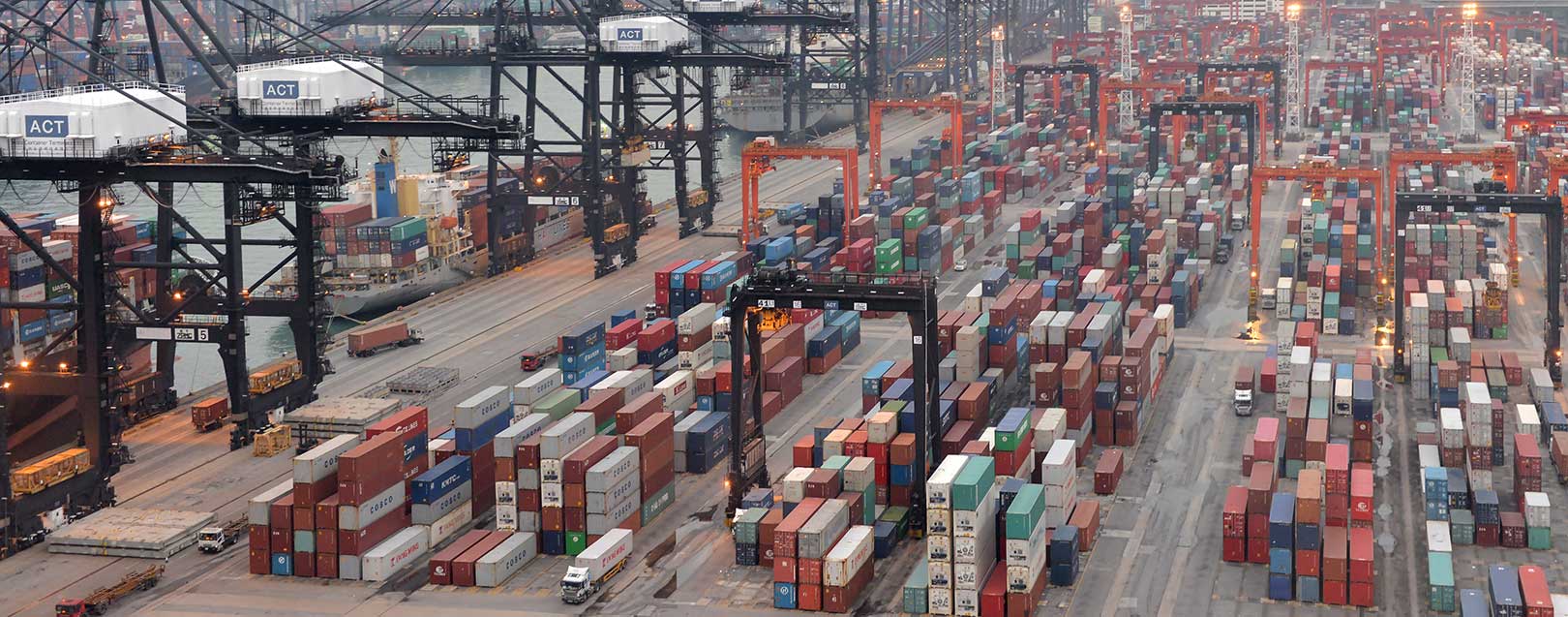
Feb exports brighten foreign trade outlook
Abin Daya
It appears that India’s export performance is back on the growth track once again. After two years of decline, exports might hit a marginal positive growth figure this year. The recovery of petro exports in value terms due to the rise in crude oil prices is one of the reasons for this growth. However, the much steeper rise in imports has widened the trade deficit, though the overall figure would still be lower than last year.
Indian exports will continue to be affected by headwinds to the global economy, though recovery in the US economy might provide some respite. The strengthening rupee is another concern for exporters as it takes away vital price advantage available to them.
Talking about individual commodities, exports of raw cotton and cotton yarn are supporting local prices despite a good harvest and availability in the local market. Prices are ruling firm thereby benefiting farmers.
The same can’t be said for pulses, though, as prices of most of them are ruling slightly above or even below the MSP. India will have record availability of pulses this year, with local production and imports being at record levels. This is affecting farm-gate prices, and there is a chance that this will lead to lower acreage of pulses in the next crop year.
The plentiful availability of pulses had prompted the Ministry of Agriculture to re-look at some of the concessions made available to exporting countries, and it is expected that the Ministry will continue to move in this path in future.
Merchandise exports seem to have a positive growth
After declining for two years consecutively, India’s merchandise exports look to be ready for positive growth in FY17
Merchandise exports had declined by 1.3% in FY15 to $310.3Bn and further by 15.5% in FY16 to $262Bn

- Merchandise exports grew by 17.5% y-o-y in Feb 2017, rising for the sixth consecutive month, to $24.5Bn driven by growth in engineering exports, iron ore shipments and petro exports
- Exports for the Apr-Feb 2017 period at $245Bn, now post a marginal growth of 2.65% y-o-y and could end at around $265Bn for the year, a growth of 1.3% over FY16

- The decline in trade deficit during the early part of 2016 was not due to exports growing faster than imports, but due to imports declining at a much steeper rate than exports
- However, in the recent months, imports have grown faster than exports, and this has contributed to the widening of the trade deficit
- For Feb 2017, imports grew by 21.8% y-o-y, resulting in a trade deficit of $8.9Bn, as against $6.6Bn during the same month of the previous year
- The double-digit import growth of Jan and Feb 2017 have been the result of a huge surge in value of crude oil imports
- For Jan and Feb 2017, oil imports grew by 61% and 60% y-o-y, due to the dual impact of low base and increasing crude prices
- The double digit growths attained in merchandise imports, during the months of Nov, Jan and Feb have not been sufficient to pull the Apr-Feb import growth figures from negative territory
- For the Apr-Feb period, merchandise imports have declined by 3.4%; oil imports have declined by 1.66%, while non-oil imports have declined by 3.9% during the same period
- While the trade deficit has widened in the recent months, thanks to the faster growth of imports, the overall figure for the year would still be less than $118.7Bn, the deficit for last year

India’s outward remittances performed well
- In the case of services trade(remittances), except for Apr 2016, imports (outward remittances) have grown much faster than exports (inward remittances)
- The services trade has been dominated primarily by the ICT sector – share of ICT sector in GDP has grown from 3.4% to 5.9% between FY01 and FY08, and share of ICT services in ICT GDP has grown from 89.5% to 94.2% during the same period
- The ICT sector has witnessed two peculiarities in its performance –
- Domestic production of IT hardware has not kept pace with the burgeoning demand leading to increased import of hardware which increased from $1.41Bn in 2000 to $8.3Bn in 2015
- Software exports have grown from $15.9Bn in 2005 to $55Bn in 2015, but the pace of growth has fallen drastically in recent times. This should also be seen in the light of the large base
- YTD (Apr to Jan) export of services has grown by 2.72% y-o-y ($133Bn against $129Bn), while imports have grown by 13.2% ($80Bn against $70.6Bn)
- Services trade has always been characterised by a trade surplus unlike merchandise trade, but the faster pace of imports growth has resulted in a 10% drop in average trade surplus in the past 10 months – from $5.93Bn to $5.35Bn
- India’s foreign trade will be subject to the impact of two factors – global demand and price advantage due to the strength of the currency
The global economy is still not in a great place, with the IMF projecting 2016 growth at 3.1% as against 3.2% in 2015
- However, the US economy, which is still our largest export market, seems to be growing, and that should be provided some relief to our exporters
- The INR has been strengthening recently, which takes away any price advantage that our exporters might enjoy
- There are indications that the RBI is intervening in the market to prevent the INR from appreciating too strongly. FX reserves for the week ending Mar 17 have gone up by $2.7Bn, the biggest increase in 27 weeks, to $366.8Bn
Exports spur cotton demand; supports price
- Prices of raw cotton have remained fairly firm in the domestic market, despite a small dip in the beginning of the month
- This is despite an improved availability of cotton in the domestic market, as indicated by the below chart

Supply is including domestic production and import of raw cotton, while demand comprises of local use (mill consumption, SSI units and non-mill use) and exports
- While production has increased by approximately 300,000 bales in 2016-17 season, imports have dropped by about 400,000 bales, which has led to a marginal drop in overall supply as compared to the 2015-16 season
- Local demand is estimated to be around 29 million bales, but Chinese demand for yarn is expected to pick up, leading to more than expected demand from local mills
- Cotton exports in the current season is expected to be around 55.5 million bales, which is again pushing up the prices of raw cotton
- India exports cotton primarily to buyers in Vietnam and Bangladesh
- These factors have led to a strong recovery of cotton demand and prices in the market, and at farm level, prices are expected to touch around Rs.6,500 per quintal
(*1 bale = 170 kg)
MBR fumigation of food imports likely to be extended
- Ministry of Agriculture is likely to keep on hold, the implementation of its communication stating that fumigation of import consignments at Indian ports should stop after Mar 31, 2017
- The issue relates to permission granted to exporter countries like Canada and Australia to fumigate pulses and lentil consignments at Indian ports with Methyl Bromide, an Ozone-depleting chemical
- As per the Ministry, the permission was actually an exemption from the requirement that shipments should be fumigated before arriving at Indian ports, and was granted and extended multiple times for more than a decade, to counter the severe shortage of pulses in the domestic market
- The use of MBR, an Ozone-depleting chemical, was always looked upon unfavourably, and considering the record pulses harvest in the current crop year – 22.1Mn tonnes as against 16.4Mn tonnes – had given enough leeway to remove the exemption beyond Mar 31
- However, in light of the representations made by the various exporting countries, it is likely that the Ministry might agree for a review of its decision, and permit the extension to continue beyond the specified date
- The indications are that such extension, even if provided, will be for a short tenor, and not for the entire year, and the final decision is to stop permitting such fumigation at Indian ports
- Indian import of pulses are set to touch a record high of 6 Mn tonnes during FY17, and combined with the record harvest, aggregate availability of pulses in the country could touch 28 Mn tonnes this year, putting pressure on prices in the local market
- Farm-gate prices of many pulses are ruling at or below the MSP and the slow pace of procurement by designated agencies is not helping prices
-
Arhar/tur dal is currently selling below the MSP, while urad and chana are ruling at or near the MSP
-
If domestic prices are not stabilised, it could lead to farmers moving away from the crop, resulting in lower acreage in the next crop year, and consequently, lower output in the next season
Some numbers to note:
*figures in brackets indicate movement during the week
· FX reserves: $366.78Bn as on Mar 17, 2017, as against $364.11Bn in the previous week (+$2.67Bn)
· USD/INR: Rs.65.4050/$ (INR appreciated by Re 0.05)
· Indian Crude Basket: $49.64 (-2.2%)/Rs.3,247.61 (-2.15%)
· Equity Markets: Sensex 29,421.40 (-0.77%); NIFTY 9,108 (-0.57%)
· LIBOR: 6 Mths – 143 bppa; 12 Mths – 180 bppa
· MIBOR: Overnight – 6.15; 1 month – 6.50; 3 months – 6.59
Abin Daya the author of 'Basics of Trade: An India Perspective' is a FEMA expert, a career transaction banker, with close to 15 years of experience in corporate and transaction banking, in I.jpg) ndia.
ndia.






 to success.
to success.